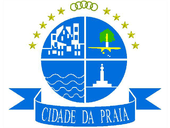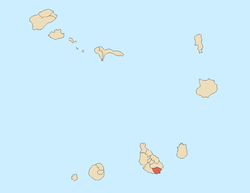Praia
| Praia | |
|---|---|
| City | |
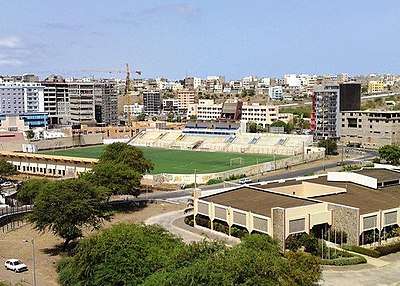 Praia, Cape Verde | |
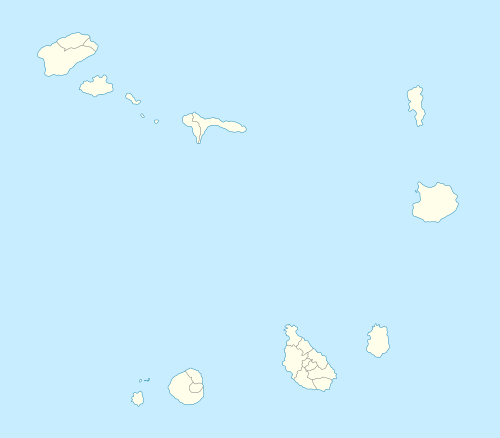 Praia Location of Praia in Cape Verde  Praia Praia (Africa) | |
| Coordinates: 14°55′05″N 23°30′32″W / 14.918°N 23.509°WCoordinates: 14°55′05″N 23°30′32″W / 14.918°N 23.509°W | |
| Island | Santiago |
| Municipality | Praia |
| Civil Parish | Nossa Senhora da Graça |
| Founded | 16th century |
| City | 1858 |
| Area | |
| • Total | 102.6 km2 (39.6 sq mi) |
| Population (2017 estimate) | |
| • Total | 159,050 |
| • Density | 1,600/km2 (4,000/sq mi) |
| Time zone | CVT |
Praia (Portuguese pronunciation: [ˈpɾajɐ], lit. "beach", in both Portuguese and Cape Verdean Creole), is the capital and largest city[1]:32 of Cape Verde, an island nation in the Atlantic Ocean west of Senegal. It lies on the southern coast of Santiago island in the Sotavento Islands group. It is the island's ferry port and is home to one of the nation’s four international airports. The city centre is known as Plateau due to its location on a small plateau.
Praia is a centre of commerce, government and education, and a port that ships coffee, sugar cane, and tropical fruits. It is the seat of the Praia municipality.
History
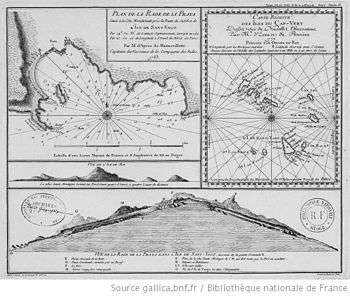
The island of Santiago was discovered by António da Noli in 1460.[2]:73 The first settlement on the island was Ribeira Grande (Cidade Velha). The village Praia de Santa Maria was first mentioned around 1516 and grew near the natural harbour.[2]:77 The ports of Santiago were important ports of call for ships sailing between Portugal and the Portuguese colonies in Africa and South America. Between the end of the 16th century and the end of the 18th century, both Ribeira Grande and Praia suffered many pirate attacks, including those by Francis Drake (1585) and Jacques Cassard (1712).[2]:195
Due to its strategic position on a plateau it had better protection against pirate attacks, which gave it a large advantage over the older city of Ribeira Grande (Cidade Velha). It gradually superseded Cidade Velha to become the most important settlement of Cape Verde, and became the capital of Cape Verde in 1770.[3] The naval battle of Porto Praya took place at Praia Harbour on 16 April 1781, as Portugal was neutral, it involved Great Britain and France and ended in a tactical draw and French strategic victory. Praia was the first stop of Charles Darwin's voyage with HMS Beagle in 1832.[4]
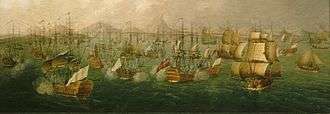
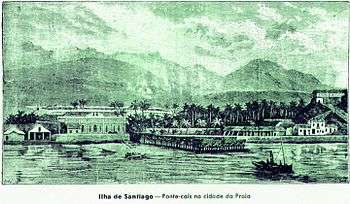
In the course of the 19th century, the Plateau was completely redeveloped with streets according to a grid plan, lined with grand colonial buildings and mansions.[3][5] Praia officially became a city (cidade) in 1858, which secured its status as the capital of Cabo Verde, concentrating political, religious and economic roles.[2]:55 In the early 1920s, the population was around 21,000.[6]
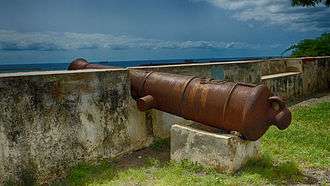
As in other parts of the archipelago, resistance against Portuguese rule rose in the 1950s. There was no open independence war like in Guinea-Bissau; after the 1974 Carnation Revolution in Portugal and the resulting end of the Portuguese Colonial War, Cape Verde declared independence in July 1975. After independence, Praia underwent a demographic boom, receiving migrating movements from all the islands. As a result, 56% of the entire population of Cabo Verde currently resides in Santiago; and 29% in the Municipality of Praia alone. Its estimated population has reached 151,436 (2015).[1]:36 On June 28, 1985, Praia became member of UCCLA, the Union of Luso - Afro-Americo-Asiatic Capital Cities, an international organization.[7]
Geography
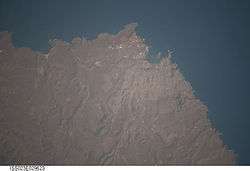
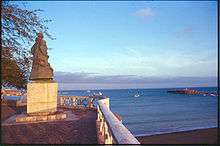
Geographically, Praia may be described as a set of plateaus and their surrounding valleys. These plateaus generally have the name achada (Achada de Santo António, Achada de São Filipe, Achada Eugénio Lima, Achada Grande, Achadinha, etc. — achada being a Portuguese word to designate a volcanic plateau), but the central one is colloquially called Plateau (in Portuguese itself). The urban settlement is made mostly on top of these plateaus and along the valleys. The islet of Santa Maria is in front of the beach bearing the same name (today more known as Gamboa).
For a long time, only the Plateau was considered to be the city, being the other neighbourhoods relegated to the condition of peripheral suburbs, in spite of always having a close relationship with the Plateau (people movements, goods and services exchanges, etc.). This is why only the Plateau previously had relatively well-developed urbanization with its own infra-structures. The remaining neighbourhoods developed in a more organic, chaotic way.
.jpg)
Only after independence did the Plateau merge with the other neighbourhoods to constitute what is now considered the City of Praia. The whole city was, at the time, equipped with adequate infrastructure. Urbanization begun immediately after independence and sought to expand north.
Climate
Praia has a mild desert climate (Köppen: BWh) with a short wet season and a lengthy, very pronounced dry season. In fact, outside of the months of August, September and October, little precipitation falls on Praia. The city on average sees about 210 millimetres (8.3 in) of rain per year. Since the coldest month is far above 18 °C (64 °F) its temperature patterns resembles a tropical climate, but lacks enough precipitation to be classified as such. Despite the fact that it has an arid climate, Praia seldom gets very hot or very cold, due to its oceanside location on Santiago Island. Temperatures are warm and constant with an average high temperature of 27 °C (81 °F) and an average low temperature of 22 °C (72 °F).
| Climate data for Praia | |||||||||||||
|---|---|---|---|---|---|---|---|---|---|---|---|---|---|
| Month | Jan | Feb | Mar | Apr | May | Jun | Jul | Aug | Sep | Oct | Nov | Dec | Year |
| Average high °C (°F) | 25 (77) |
25 (77) |
25.6 (78.1) |
26.1 (79) |
27.2 (81) |
27.8 (82) |
28.3 (82.9) |
28.9 (84) |
28.9 (84) |
29.4 (84.9) |
27.8 (82) |
26.1 (79) |
27.2 (80.9) |
| Average low °C (°F) | 20 (68) |
19.4 (66.9) |
20 (68) |
20.6 (69.1) |
21.1 (70) |
21.1 (70) |
23.9 (75) |
24.4 (75.9) |
25 (77) |
24.4 (75.9) |
23.3 (73.9) |
21.7 (71.1) |
22.1 (71.7) |
| Average rainfall mm (inches) | 2.5 (0.098) |
1.3 (0.051) |
1 (0.04) |
2.3 (0.091) |
0 (0) |
1 (0.04) |
13.2 (0.52) |
99.3 (3.909) |
29 (1.14) |
47.5 (1.87) |
7.9 (0.311) |
4.6 (0.181) |
209.6 (8.251) |
| Source #1: Sistema de Clasificación Bioclimática Mundial[8] | |||||||||||||
| Source #2: BBC Weather[9] Wetterkontor[10] | |||||||||||||
Society
Demographics
.jpg)
As of the mid-19th century, the population was estimated at 1,500 to 2,000. When Edmund Roberts visited in 1832, he noted a population of black people in Praia totaling about "nineteen twentieths" of the population.[11] According to the national statistics office, the city's population is estimated 159,050 as of July 2017.
| Population of the city of Praia (1990–2017)[12] | |||
|---|---|---|---|
| 1990 | 2000 | 2010 | 2017 |
| 61,644 | 94,161 | 130,271 | 159,050 |
Education
.jpg)

The city of Praia is home to the first primary school in the archipelago, originally known as the Escola Central (today known as the Escola Grande). For much time it was the only primary school in Praia. At the beginning of the 1960s, other primary schools began to be built in neighbourhoods around the Plateau and in other localities on the island.
Praia was also the first site in Cabo Verde with a secondary education institution with the creation of the Liceu Nacional in 1861. However, the Portuguese authorities were not interested in implementing secondary education in Cabo Verde and the school failed as a result; secondary education became, afterwards, the role of the Seminário de Ribeira Brava on the island of São Nicolau, and later of the lyceum in Mindelo.
In 1960, Praia again had secondary education, first with a facility on September 12 Plaza and later in its own building. With the expansion of education in Cabo Verde in the 1990s, various buildings dedicated to education were constructed in Cabo Verde, and Praia currently (2016) has 12 secondary education schools.
International schools:
- École Internationale Les Alizés (French school)
- Colégio Internacional – Cabo Verde (Portuguese school)[13]
For higher education, there are the Universidade de Santiago, Instituto Superior de Ciencias Juridícas e Sociais, Instituto Superior de Ciencias Económicas e Empresariais, Jean Piaget University of Cape Verde, and University of Cape Verde.
Praia is also home to the National Library and the National Archives Building or the ANCV.
Economy
.jpg)
The principal economic activities of Praia belong to the tertiary sector. Beyond activities related to administration and governance (local and national), there are extensive commerce, services (health care, education, tourism, restaurants and hotels, public functions, etc.), and other activities of a liberal character.
Being the nation´s capital as well as the economic hub, Praia is one of the most economically viable cities in the Cabo Verde archipelago. About one third (1/3) of the city's population lives below the poverty line today (2014). The gross metropolitan product for the city is about 39% of the country's GDP, translating into US$4764 income per capita.
TACV Cabo Verde, the national airline of Cabo Verde, has its headquarters in Praia.[14]
Infrastructure
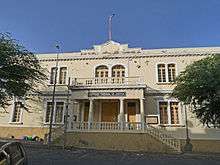
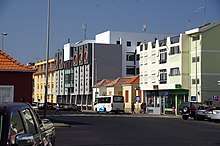
The city is served by Nelson Mandela International Airport and TACV Cabo Verde Airlines. It has the nation's second most used port, Praia Harbor, with a ferry terminal linking to other islands, direct ferry routes are Maio, Fogo and São Vicente. The port is managed by the national port authority ENAPOR. The port was reconstructed and expanded in 2014.[15]
Praia has a dual carriageway ring road, the Circular da Praia (EN1-ST06), which is connected with the main national roads to the north (EN1-ST01) and the west (EN1-ST05) of the island. The main roads inside the city are Avenida Grão Ducado de Luxemburgo (from the centre to the west), Avenida Amílcar Cabral (in Plateau) and Avenida Cidade de Lisboa.
Public transport
Public transport within the city of Praia is provided by the company SolAtlântico. There are 12 city bus lines. Intercity share taxis for other cities on the island of Santiago depart from the Sucupira terminal in the city centre, which was opened in May 2018.[16] In 2015 a project called EcobusCV started running a fleet of dual fuel waste vegetable oil / diesel minibuses between Praia and Assomada. However, services were suspended in November 2016.[17]
Attractions and amenities
.jpg)
Landmarks in the colonial city center include Albuquerque Square (named after the colonial governor of the mid 19th century, Caetano Alexandre de Almeida e Albuquerque), the old city hall built in the 1920s, the Presidential Palace, which was constructed in the end of the 19th century to house the Portuguese governor and the Monumento de Diogo Gomes, named after the Portuguese navigator who discovered the island of Santiago in 1460.
There is the Museu Etnográfico (Ethnographic Museum), which was founded in 1997. Some of the oldest buildings in Praia are Jaime Mota Barracks (Quartel Jaime Mota) dating from 1826. Since 2016, the historic centre of Praia is on the tentative list of World Heritage sites.[3]
Sports
Praia is home to several sports teams. The most popular football (soccer) clubs include Sporting, Boavista, Travadores, Académica, Vitória and Desportivo; others include ADESBA, based in Craveiro Lopes; Celtic, based in Achadinha de Baixo; Tchadense, based out of Achada Santo Antônio; Delta, and Eugênio Lima, based in that neighbourhood. Basketball clubs include ABC Praia, Bairro and Travadores. Volleyball clubs include Desportivo da Praia. All are part of the Santiago League South Zone. Many clubs play at Estádio da Várzea.
Notable residents and visitors
- Ivan Almeida, basketball player
- Gardénia Benrós, singer
- Carlos Pedro Silva Morais, nickname: Carlos, footballer
- Charles Darwin is known to have traveled to Porto Praya, evident from his Voyage of the Beagle.
- Mito Elias, artist
- Gelson Fernandes, a footballer who currently plays for Eintracht Frankfurt and Switzerland.
- Dário Furtado, footballer
- Nando Maria Neves, footballer
- Nani, a footballer who currently plays for Valencia and Portugal.
- Ronny, footballer
- Yara dos Santos, writer
- Vadú, singer
- Arménio Vieira, writer, winner of the 2009 Camões Prize
International relations
Praia is twinned with:



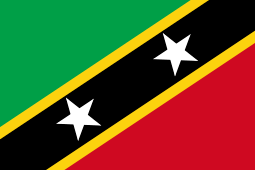


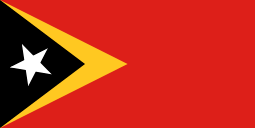





The city of Praia also has three official sister cities:[22] [23]

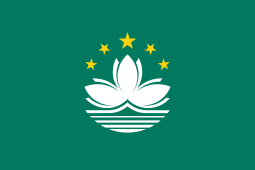

See also
References
- 1 2 Cabo Verde, Statistical Yearbook 2015, Instituto Nacional de Estatística
- 1 2 3 4 Valor simbólico do centro histórico da Praia, Lourenço Conceição Gomes, Universidade Portucalense, 2008
- 1 2 3 Centre historique de Praia, UNESCO
- ↑ Journal of researches into the natural history and geology of the countries visited during the voyage of H.M.S. Beagle round the world - Chapter 1 at Wikisource, top part
- ↑ Antigas residências senhoriais do Centro Histórico da Praia, Domingas Andrade Silva Barbosa de Pina, Universidade de Cabo Verde, 2009
- ↑ Habbel, Josef (1925). Habbels Konversationslexikon. 3. Regensburg. p. 1043.
- ↑ "Site of the City of Lisbon: UCCLA" (in Portuguese). City of Lisbon. Retrieved 11 October 2016.
- ↑ "Cape Verde – Praia". Centro de Investigaciones Fitosociológicas. Retrieved December 2, 2013.
- ↑ "Average Conditions Praia, Cape Verde". BBC Weather. August 2010. Retrieved December 2, 2013.
- ↑ "Temperatures of Praia". wetterkontor.de.
- ↑ Roberts, Edmund (1837). Embassy to the Eastern Courts of Cochin-China, Siam, and Muscat. New York: Harper & Brothers. pp. 19–20.
- ↑ Source: City Population, citing the Instituto Nacional de Estatísticas Archived 2008-11-18 at the Wayback Machine..
- ↑ "ESCOLAS COM CURRÍCULO PORTUGUÊS EM CABO VERDE" (Archive). Direção de Serviços de Ensino e Escolas Portuguesas no Estrangeiro (DSEEPE) of the Portuguese Education Ministry. Retrieved on October 27, 2015.
- ↑ "Contact." TACV Cabo Verde. Retrieved on 23 October 2009.
- ↑ "Information about the port" (in Portuguese). ENAPOR. Retrieved 23 August 2018.
- ↑ "Santiago: Condutores de hiace satisfeitos com o terminal da Praia". SAPO Notícias. 2018-07-03.
- ↑ "Ecobus suspende rota Praia/Assomada/Praia". Expresso das Ilhas. 2016-11-07.
- ↑ "Geminações de Cidades e Vilas". Associação Nacional de Municípios Portugueses (in Portuguese). Retrieved 2013-07-20.
- ↑ "Lisboa – Geminações de Cidades e Vilas" [Lisbon – Twinning of Cities and Towns]. Associação Nacional de Municípios Portugueses [National Association of Portuguese Municipalities] (in Portuguese). Retrieved 2013-08-23.
- ↑ "Acordos de Geminação, de Cooperação e/ou Amizade da Cidade de Lisboa" [Lisbon – Twinning Agreements, Cooperation and Friendship]. Camara Municipal de Lisboa (in Portuguese). Retrieved 2013-08-23.
- ↑ http://www.uccla.pt/membro/dili
- ↑ "Praia Sister Cities". Sister Cities International. Retrieved 2016-05-05.
- ↑ https://www.iacm.gov.mo/e/gemin/detail/15d0c8e5-174b-4ffc-a741-087e551362d8
External links
| Wikimedia Commons has media related to Praia, Cape Verde. |
| Wikivoyage has a travel guide for Praia. |
Gallery
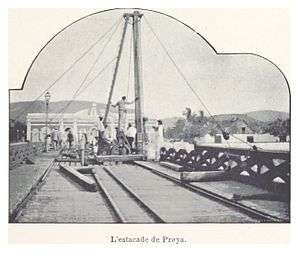 Port of Praia, 1899
Port of Praia, 1899 Market of Praia, 1899
Market of Praia, 1899 Maize mill, Praia, 1899
Maize mill, Praia, 1899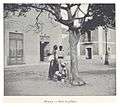 Square in Praia, 1899
Square in Praia, 1899 Praia, 1899
Praia, 1899 Gamboa panorama from Plateau
Gamboa panorama from Plateau
